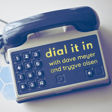
S3 Ep29: Unveiling Print's Power – A Dialogue with Mike Saty
In this episode of Dial It In, Trygve and Dave discuss the importance of print marketing, despite the prominence of digital media. They welcome guest Mike Saty, Chief Sales Officer at Signature Graphics, who outlines the broad range of services their company offers, including commercial printing, direct mail, and design services through their associated companies. Saty emphasizes the continuing relevance of print media, explaining its adaptability and impact, especially in integrated marketing campaigns. He provides insights into the logistical and strategic considerations of print advertising and shares innovative examples, such as integrating digital elements through QR codes and programmatic mail. The conversation also touches on the challenges of supply chain disruptions and rising costs, and how Signature Graphics navigates these issues to offer comprehensive solutions for clients. Throughout, Saty stresses the importance of meeting client needs through a consultative approach and outlines his strategies for managing diverse sales objectives across different markets.
Connect with Mike:
Signature-Graphics.com
LinkedIn
…
Dial It In Podcast is where we gather our favorite people together to share their advice on how to drive revenue, through storytelling and without the boring sales jargon. Our primary focus is marketing and sales for manufacturing and B2B service businesses, but we’ll cover topics across the entire spectrum of business. This isn’t a deep, naval-gazing show… we like to have lively chats that are fun, and full of useful insights. Brought to you by BizzyWeb.
Links:
Website: dialitinpodcast.com
BizzyWeb site: bizzyweb.com
Connect with Dave Meyer
Connect with Trygve Olsen

